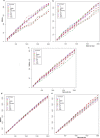Statistical Approach for Gene Set Analysis with Trait Specific Quantitative Trait Loci
- PMID: 29402907
- PMCID: PMC5799309
- DOI: 10.1038/s41598-018-19736-w
Statistical Approach for Gene Set Analysis with Trait Specific Quantitative Trait Loci
Abstract
The analysis of gene sets is usually carried out based on gene ontology terms and known biological pathways. These approaches may not establish any formal relation between genotype and trait specific phenotype. In plant biology and breeding, analysis of gene sets with trait specific Quantitative Trait Loci (QTL) data are considered as great source for biological knowledge discovery. Therefore, we proposed an innovative statistical approach called Gene Set Analysis with QTLs (GSAQ) for interpreting gene expression data in context of gene sets with traits. The utility of GSAQ was studied on five different complex abiotic and biotic stress scenarios in rice, which yields specific trait/stress enriched gene sets. Further, the GSAQ approach was more innovative and effective in performing gene set analysis with underlying QTLs and identifying QTL candidate genes than the existing approach. The GSAQ approach also provided two potential biological relevant criteria for performance analysis of gene selection methods. Based on this proposed approach, an R package, i.e., GSAQ ( https://cran.r-project.org/web/packages/GSAQ ) has been developed. The GSAQ approach provides a valuable platform for integrating the gene expression data with genetically rich QTL data.
Conflict of interest statement
The authors declare that they have no competing interests.
Figures




Similar articles
-
Genome wide association mapping for grain shape traits in indica rice.Planta. 2016 Oct;244(4):819-30. doi: 10.1007/s00425-016-2548-9. Epub 2016 May 19. Planta. 2016. PMID: 27198135 Free PMC article.
-
Quantitative trait loci identification and meta-analysis for rice panicle-related traits.Mol Genet Genomics. 2016 Oct;291(5):1927-40. doi: 10.1007/s00438-016-1227-7. Epub 2016 Jul 5. Mol Genet Genomics. 2016. PMID: 27380139
-
The genetic and molecular origin of natural variation for the fragrance trait in an elite Malaysian aromatic rice through quantitative trait loci mapping using SSR and gene-based markers.Gene. 2015 Jan 25;555(2):101-7. doi: 10.1016/j.gene.2014.10.048. Epub 2014 Oct 29. Gene. 2015. PMID: 25445269
-
Crop management impacts the efficiency of quantitative trait loci (QTL) detection and use: case study of fruit load×QTL interactions.J Exp Bot. 2014 Jan;65(1):11-22. doi: 10.1093/jxb/ert365. Epub 2013 Nov 13. J Exp Bot. 2014. PMID: 24227339 Review.
-
Toward knowledge support for analysis and interpretation of complex traits.Genome Biol. 2013;14(9):214. doi: 10.1186/gb-2013-14-9-214. Genome Biol. 2013. PMID: 24079802 Free PMC article. Review.
Cited by
-
Fifteen Years of Gene Set Analysis for High-Throughput Genomic Data: A Review of Statistical Approaches and Future Challenges.Entropy (Basel). 2020 Apr 10;22(4):427. doi: 10.3390/e22040427. Entropy (Basel). 2020. PMID: 33286201 Free PMC article. Review.
-
The hitchhikers' guide to RNA sequencing and functional analysis.Brief Bioinform. 2023 Jan 19;24(1):bbac529. doi: 10.1093/bib/bbac529. Brief Bioinform. 2023. PMID: 36617463 Free PMC article.
-
Differential Expression Analysis of Single-Cell RNA-Seq Data: Current Statistical Approaches and Outstanding Challenges.Entropy (Basel). 2022 Jul 18;24(7):995. doi: 10.3390/e24070995. Entropy (Basel). 2022. PMID: 35885218 Free PMC article. Review.
-
Statistical Approach of Gene Set Analysis with Quantitative Trait Loci for Crop Gene Expression Studies.Entropy (Basel). 2021 Jul 23;23(8):945. doi: 10.3390/e23080945. Entropy (Basel). 2021. PMID: 34441085 Free PMC article.
-
Meta-analysis of RNA-Seq datasets highlights novel genes/pathways involved in fat deposition in fat-tail of sheep.Front Vet Sci. 2023 May 12;10:1159921. doi: 10.3389/fvets.2023.1159921. eCollection 2023. Front Vet Sci. 2023. PMID: 37252399 Free PMC article.
References
-
- Das S, Meher PK, Rai A, Bhar LM, Mandal BN. Statistical approaches for gene selection, hub gene identification and module interaction in gene co-expression network analysis: An application to Aluminum stress in Soybean (Glycine max L.) PLoS One. 2017;12(1):e0169605. doi: 10.1371/journal.pone.0169605. - DOI - PMC - PubMed
Publication types
MeSH terms
Grants and funding
LinkOut - more resources
Full Text Sources
Other Literature Sources

